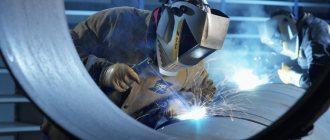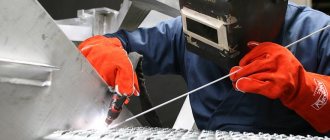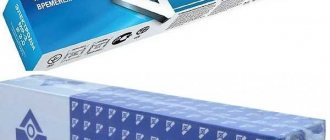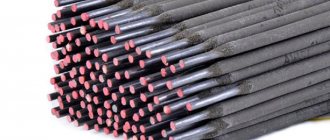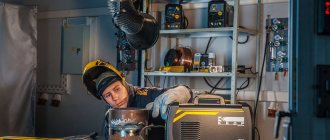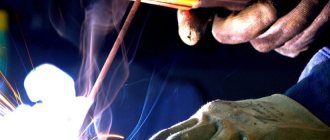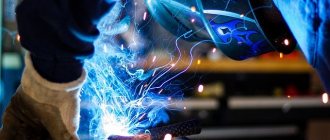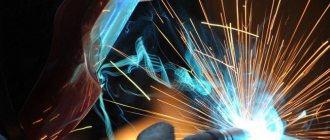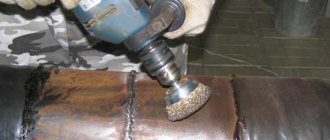The marking of welding electrodes (SE) contains information such as type, brand, diameter and other technical characteristics.
LE3ANO-21
An example of marking and its interpretation: E46-LEZAHO-21-⌀-UD E4Z 1(Z)-RTs1Z, where
● Type. Products of this type are used to work with metal structures made of steels whose tensile strength is 46 kgf/mm2.
● Brand. The main purpose of LEZANO-21 is to create permanent connections during the installation of ordinary and critical metal structures in cases where increased requirements are placed on connections.
● Purpose of SE. The U index indicates that SEs can be used to work with structural elements made of steel with a maximum tensile strength of up to 588 MPa (60 KGS/MM2).
● Coating thickness coefficient. The letter D indicates a coating of increased thickness.
● Type of meltable coating. According to the accepted marking system, this type of coating is marked with the letter E.
● Tensile strength. Index 4З is equal to 4З0 MPa (4З KГС/MM2).
● Relative elongation. The number 1 indicates a value of 20%.
● Min.t, at which the impact strength of the connecting seams is not lower than 34 J/CM2 (3.5 KGS M/CM2). The number Z corresponds to t -20C.
● Type of coverage. Coatings based on rutile and cellulose are marked PC.
● Possible positions during welding work. Number 1 indicates the ability to work in any position, including ceiling, sub-ceiling, semi-horizontal, semi-vertical.
● Welding current. Code 3 indicates that welding of structural elements with direct current of any polarity or alternating current from energy sources with an open circuit voltage of 50±3V.
ANO-21
Decoding of marking E46-AHO-21-2,5-UD E 4З0(З)-P-11 is carried out in the following order:
● SE type. Electrodes of this type are designed to work with metal structures made of steel with a tensile strength of 46 KGS/MM2.
● Brand. ANO -21.
● Rod thickness. In this case, the specified diameter is 2.5 mm.
● Purpose. The Y marking means that the products are intended to work with steels whose tensile strength is 588 MPa (60 KGS/MM2).
● Coating thickness coefficient. Index D means that the electrodes have a thick coating.
● The presence of a melting coating is indicated by the letter E.
● Strength to tensile loads. Code 4З corresponds to 4З0 MPA (44 KГС/MM2).
● Relative elongation. The number 0 indicates a relative elongation of 20%.
● Min temperature at which the impact strength of the weld is not lower than 34 J/CM2 (3.5 KGS M/CM2). Code Z indicates t -20C.
● Coating material. Rutile is used as a type P coating for solar cells.
● Acceptable spatial positions. The number 1 is indicated in cases where welding work can be carried out in any position.
● Welding current and open circuit voltage. The next unit is indicated in cases where welding is performed with alternating or direct current with a voltage of 50V.
MP-3 PLA3MA
Example of marking E46-MP-3 PLA3MA-⌀-UD E 4З0(З)-P26 and interpretation.
● Type and brand. Electrodes of this brand are intended for arc welding of metal structures in any position in space, with the exception of vertical.
● Scope of application. Electrodes designated by code U are used to work with alloys that have tensile strength. up to 588 MPa (60 KGS/MM).
● Coating thickness. Thick coating is marked with code D.
● Type of coverage. In accordance with the international classification system, fusible coatings are designated by the index E.
● Tensile strength equal to 430 MPa (44 KGS/MM2), indicated by the digital code 43.
● A relative elongation of 20% is marked with the number 0.
● The minimum t values at which the strength of the connecting seam is maintained is -20C and is designated by the index Z.
● A coating containing 48% rutile, 25% feldspar, 10% liquid glass, 10-13% each of magnesite and ferromanganese is designated by the letter P.
● The method of applying a weld, other than vertical, is indicated by the number 2.
● The number 6 indicates that work should be carried out at a voltage of 70V.
UOHI-13/55
The marking E50A-UONI-1Z/55-Z,0-UD E514(4)-B20 is deciphered as follows:
● Type and brand. SEs of this category are used to work with carbon and low-alloy alloys, whose tensile strength is 50 KGS/MM2. The letter A denotes increased ductility and impact strength of the connecting seam.
● Diameter. The thickness of the rod is 3.0 mm.
● Scope of application. Electrodes marked with the letter U are used to create permanent connections during the installation of metal structures made of alloys with a tensile strength of 588.3 MPa (60 KGS/MM2).
● Thickness and characteristics of the coating. A thick non-melting coating is designated by the indices D and E.
● Mechanical properties. The combination of numbers 51 indicates a tensile strength of 510 MPa (52 KGS/MM2), and the number 4 indicates a relative elongation of the metal of 20%. The minimum temperature at which the weld metal retains the specified strength is indicated by the number 4, which corresponds to -30C.
● Type of coverage. The main type of coating is marked with the letter B.
● Position in space. The number 2 in the SE marking corresponds to any position other than vertical.
● Welding current. The number 0 indicates the possibility of carrying out work with direct current of reverse polarity.
TsL-11
Decoding of the marking code E-08X20H9G2B-TsL-⌀-BD E-2005-B20:
● Type and brand. This type of electrodes is designed to work with parts and structures made of high-alloy steels.
● Scope of application. The index B denotes SEs used to connect elements of metal structures made of alloys with special properties.
● Coating characteristics. A thick coating of a melting type is marked DE.
● Methods for testing the resistance of connecting weld metal to intercrystalline corrosion. AM and AMU methods are designated by the number 2.
● The amount of fine delta ferrite in the weld metal. The number 5 corresponds to the ferrite phase content from 2% to 10%.
● Type of coverage. Marking B indicates that a base coat is being used.
● Welding current. The number 0 indicates that welding work is carried out with direct current of reverse polarity.
Video description
Explanation of electrode designations.
Below we will talk about the classification of electrode elements, their purpose and properties.
The purpose of the metal rod is to fuse the material being welded to a specific place where the workpiece is joined. The main part of the electrode serves to conduct current through itself. The end of the consumable melts under the influence of the elevated temperature of the welding arc. At the moment of melting of the end of the electrode, a complete product is formed together with the molten structure.
What does a consumable electrode consist of?
The welding electrode has a simple structure. Its main component is the rod; a special coating is made on the outside. The end that melts and comes into contact with the material being welded is made without coating.
What is the difference, what is the difference between MR and ANO, USENI, OZS, OK
Electrodes of brands MR, ANO, OZS and have a rutile coating. This determines their similarity in the features of welding technology . However, some specific modifications for specific welding jobs may have minor differences from other brands of rutile-coated electrodes.
Electrode MR-3S
The UONI brand of electrodes has a basic coating, which makes the difference with MR brand electrodes very significant :
- the properties of rutile coating differ in their effect on the welding process from the main coating;
- unlike MR, which are used both on direct current and alternating current, UONI brand electrodes can only be welded on direct current of reverse polarity;
- MR requires much less preparation of the surface of the materials being welded than SSSI;
- SSSI is many times more sensitive to moisture than MR.
Which ones are better for the inverter and in other situations
The electrode brand does not play a decisive role in choosing an inverter or other welding equipment. It is important that the characteristics of the additive match the capabilities of the device. The main thing is to choose the right filler material for the materials being welded.
Type of rods and explanation of electrode markings
Any container in which welding rods are packaged has an alphanumeric coding, for example: E50A-UONI – 13/55 – 5.0 – UD / E514 (4) – B20
Marking of rods Source bsm21.ru
Electrodes, their markings
The first digits of the designation in our illustrative example indicate the type of rod. E50A - consumables that can be used for welding steel reinforced and non-reinforced metal. To make the abbreviation easier to understand, it is recommended to break it down into its components:
- E - rod is used for welding on an arc machine.
- 50 is the maximum value of the connection strength.
In our sample, this parameter is 50 kgf per 1 sq. mm.
- A – the joint has load toughness and good flexibility.
From this sample it is clear that it is possible to understand the decoding of the electrodes; it cannot be considered a difficult task. If you have an explanation at hand of what the digital and alphabetic signs mean, any beginner will understand.
Decoding the abbreviation, what the symbols in the marking mean
The label provides information about technical characteristics in a concise form. So, for example, certain electrodes of the MP-3 brand have the following designation - “E46 - MP-3 LEZ - 4 - US / E432 (3) - P21.” The above letters and numbers include the following contents:
- E46 - indicates the type of electrode, specifically in this case for welding low-carbon and carbon steels (with a carbon content of up to 0.25%) with a tensile strength of no more than 46 kgf/sq. mm;
- MR-3 LEZ - denotes the brand of electrode and its manufacturer, in this case MR-3, manufactured at the Losinoostrovsky Electrode Plant;
- 4 – indicates the diameter of the welding wire of the electrode, here 4 mm;
- U - indicates what materials the electrode is intended for welding, in this case for carbon and low-carbon steels;
- C - indicates the thickness of the coating, here C is the average thickness (there are also thin, thick and extra thick, which are marked M, D, G, respectively);
- E - indicates the relationship to the type of melting with coating;
- 43 – these numbers indicate tensile strength, namely 430 MPa;
- 2 – characteristic of relative elongation, in this case in the region of 24% or more;
- (3) – determines the minimum temperature at which the impact strength is not lower than 34 J/sq. cm, in a particular case, the number 3 corresponds to a temperature of -20°C;
- P – denotes the type of coating, here – rutile;
- 2 – the number indicates the spatial positions in which welding can be performed efficiently, in this case – in all except “top-down” in a vertical position;
- 1 – You can weld with both direct and alternating current.
Welding rods: types and characteristics
To work with reinforced products, you need rods coded “E” and hardness codes indicated by numbers: 38, 42, 46, 50, 55, 60, 70, 85, 100, 125, 150; 42A, 46A, 50A.
In the case when it is necessary to connect types of steel products that are resistant to thermal effects, consumables coded E-09 and E-10 are used. Many types of electrodes are suitable for welding high-alloy metal, their number is more than 40. The most commonly chosen electrodes are: E-12X13, E-06X13N, E-10X17T, E-12X11NMF, E-12X11NMF.
To connect materials with previously known characteristics, the following electrodes are used: E-10G2, E-12G4, E-10G3, E-16G2KhM, E-15G5, E-30G2KhM, the total number of types is 38.
Interpretation of welding electrodes
In an illustrative example, there is a UONI encoding - 13/55, which characterizes the brand of electrode. It is described in detail in the GOST section. Sometimes there is a designation patented by the manufacturer. Products of the OK group from the ESAB manufacturing brand are labeled in this way.
Electrode OK-46, d 3.0 ZAO ESAB-SVEL St. Petersburg Source molotok43.ru
Rod diameter
When deciphering the electrode markings, you can find digital symbols showing the cross-section of the consumable in mm. In the specified sample, this parameter is 5 mm. Based on this value, you need to know an important circumstance: the greater the thickness of the material being welded, the higher this parameter should be.
Purpose
In the representative sample, the letter “U”, placed almost at the end of the marking, indicates the choice of a consumable suitable for welding work with structures made of unreinforced steel raw materials, having a hardness limit of about 60 kgf per 1 mm2. When it is necessary to work with metal products with other parameters, then other symbols must be used, for example, “L”. Other letters:
- “B” is used for welding work on workpieces characterized by unusual qualities.
- "N" - for surfacing.
The letter "T" indicates that the rods are suitable for welding heat-resistant metal products.
Coating density parameter
The next letter after U is the letter code D, located in the representative sample, indicating how thick the coating layer is made. In our case, this layer is quite thick. In addition to D, the electrodes also have other letters: “M” - a slightly thick surface, closer to thin, “C” - medium size, “G” - impressive thickness.
Electrodes by thickness Source userdocs.ru
Rutile coating
The most common representatives of this type of electrodes are LEZ MR-3S, ANO-4, OZS-4. It is worth noting that this coating has more significant advantages.
The use of such consumables ensures a high-quality result even if the workpiece has various defective formations and corrosion spots. Also, the quality is not affected by humidity levels. Often the elements are used to work with 09GS steel and high-carbon materials.
There is one drawback associated with the silicon oxide content in the composition. Because of this, the formed seam has reduced impact strength and reduced flexibility. In the marking system, the coating is designated as follows:
- according to GOST 9466-75 and ISO “P” and R, respectively, according to the old GOST 9467-60
T (rutile).
In this case, the formed slag is easy to remove. This in turn further improves the quality of welding work.
Manufacturers of welding electrodes
The Russian consumables market offers a wide selection of electrodes produced by domestic manufacturers. The technological capacity of production allows us to meet the needs of individuals and enterprises in various fields of activity.
Russian electrode manufacturers are divided into 3 categories:
- Large production facilities that supply the bulk of customers with materials.
- .
- Small businesses that manufacture products to meet their own needs.
We list several manufacturing companies producing electrodes:
- SVEL - Altai welding electrode plant.
A modern facility producing a wide range of coated products.
- Belorechensky electrode.
Welding materials are produced in accordance with state standards, and the products are certified.
- "Electrode-Boron".
Manufactures universal welding electrodes.
The products of Russian manufacturers are in demand in various fields of activity and are actively purchased not only in stores in our country, but also abroad.
What problems does the electrode solve?
In general, electrodes solve several problems at once:
- The substances that make up the coating are characterized by a low ionization potential. As a result, the electric arc, after ignition, is easily saturated with free ions, which support and stabilize the combustion process.
- Coating the electrodes not only creates a gas cloud during combustion, but also contributes to the formation of a layer of slag on top of the weld. It performs a protective function and at the same time reduces the cooling rate of the molten metal. This creates favorable conditions for removing unwanted impurities or non-metallic inclusions from the seam.
- An important condition for obtaining high-quality seams is the absence of oxygen in them. Therefore, the electrode coating contains special substances – deoxidizers. During the welding process, they enter into a chemical reaction with oxygen and “bind” it.
- Another important function is alloying the weld metal with a number of elements in order to improve its properties. For this purpose, the electrode contains chromium, silicon, manganese, titanium, etc.
Purpose of electrodes
The name “electrode” itself comes from two Greek words: elektra and hodos. They are translated as "electricity" and "road".
Types of welding materials
Electrodes used in manual arc welding are divided into:
- Non-melting.
They are made from different types of materials that differ in their refractoriness: tungsten, graphite, coal. Designed to ignite and maintain the welding arc. The joints between the workpieces are filled with additives created by manually applying a consumable that melts.
- Melting.
This type of electrode melts during welding operations on the surface of the structure. Made from steel, cast iron, copper or other metal. The specific type of raw material depends on the material. The rod performs the function of an additive and also plays the role of a cathode or anode. There are electrodes coated and uncoated.
What are they intended for, areas of application, for welding what steels
The material of welding wire Sv-08 MR electrodes with low carbon content limits the use of this filler material for manual arc welding of steels with a carbon content of no more than 0.25%. The mechanical characteristics of which, namely, the tensile strength of the structures being welded, should not exceed 46 kgf/sq. mm. Only such steels will have a high-quality weld when using MR grade electrodes.
The wide applicability of low-carbon and carbon steels in various fields of industry and construction contributes to the widespread use of MP grade electrodes . Their high arc stability and easy re-ignition make them popular among welding beginners. Professionals guarantee high-quality welds on critical structures and often use MR electrodes for tack welding followed by the use of electrodes with a basic coating.
According to welding current parameters
Rods with a cross section of 4 mm. are selected for welding on simple welding devices. They are also used on the most productive and powerful units.
The length of this consumable is 35 and 45 cm. Suitable for welding thin workpieces up to 1 cm. Operates at a current of 220A. Welding consumables with a cross section from 5 to 12 mm. used only in welding work in the presence of additional lighting created by powerful lighting installations.
Aluminum rod FoxWeld AL Мg 5 (ER-5356) 1.6 mm 5 kg Source yandex.ru
What effect does the type of coating have on the performance of the electrode?
First and most importantly, the coating affects the technological parameters of the electrode itself and the workpieces that can be used. In particular, the type of coating regulates the possibility of placing welding seams, efficiency, porosity, resistance to the formation of deformation processes and the presence of hydrogen in the seam.
The composition of the acid coating is represented by a 4-element structure. The coating includes manganese, iron oxides and silicon. The most common representatives are OZCH-2 and SM-5 electrodes. And has the following markings:
- according to GOST 9466-75 and ISO, it is designated “A”, according to the old GOST 9467-60 – P (acid ore).
Important nuance : Metal rods that have an acid coating do not form pores during the electric arc welding process. They can be used to operate when connected to both direct and alternating current. But there is also a drawback - cracks can form in the weld, namely on the scar line.
During operation, such rods can release toxic substances, so it is recommended to use a special mask.

